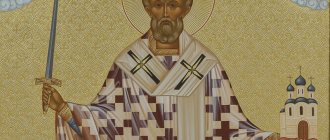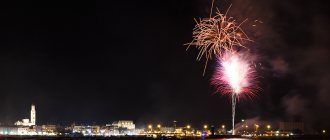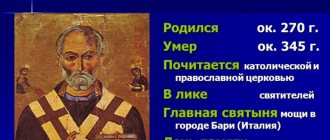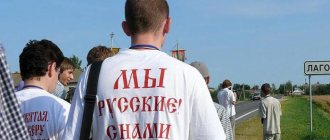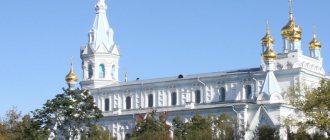Mystery document
In the afternoon of March 2, 1917, two documents signed by Nicholas II appeared in Pskov, several hours apart.
In the first text, signed from 14.45 to 15.00 and handed over to General N. Ruzsky and his entourage, the last Russian emperor abdicated the throne in favor of his son Alexei. At 4 p.m., Nicholas II sends a telegram to the chief of staff of the Supreme Commander-in-Chief, General M. Alekseev: “In the name of the good, peace and salvation of beloved Russia, I am ready to abdicate the throne in favor of my son. I ask everyone to serve him faithfully and without hypocrisy. NICHOLAY."
However, this telegram was not destined to become a historical document about the abdication of the last Russian Tsar. On March 2 at 23.40, representatives of the State Duma A. I. Guchkov and V. V. Shulgin received the final text of Nicholas II’s abdication of the throne for himself and his heir Alexei, known in history as the Abdication Manifesto. Power passed to Mikhail Alexandrovich Romanov, who the next day abdicated the throne until the convening of the Constituent Assembly.
The carriage of the royal train in which the Emperor abdicated the throne. Photo from chrontime.com
The manifesto on the abdication of Nicholas II is one of the key and mysterious documents of Russian history of the twentieth century. Until now, historians cannot come to a consensus regarding the reasons that caused its appearance.
The range of versions is unusually wide: from attempts to prove that there was no abdication, and Nicholas II deliberately signed a text that could not be legal, to the idea that the fall of the monarchy in Russia was the result of a well-organized conspiracy of military officers, deputies and dignitaries who They believed that to save the country it was necessary to remove the last autocrat from power.
Most likely, we will never be able to fully find out what exactly happened on the royal train, which was traveling from Mogilev to Tsarskoe Selo, but ended up in Pskov.
A significant number of memoirs have reached us, but their value as historical sources is unequal. Some memoirs were written much later than March 2, taking into account the political situation in Russia and the position that the author took in relation to the events of February or October 1917.
One thing is obvious: the emperor had to make a decision in a critical, constantly changing situation and in a very short time (this explains several telegrams from the sovereign).
Neither Nicholas II nor Alexandra Feodorovna could calmly communicate with each other at that moment, or get a more or less complete understanding of what was happening. What on February 25 seemed to the empress to be a revolt of “boys and girls” turned into a revolution in two days, when the troops refused to obey orders, and front commanders asked Nicholas to abdicate the throne.
Almost all sources reporting on the reasons that guided Nicholas II on March 2 talk about his reluctance to shed blood, his desire to stay with his family and live as a “private person” without leaving his homeland. Nicholas II made the decision to abdicate under strong pressure from the military and deputies and in circumstances of exceptional complexity.
Until the very last moment, the emperor hoped to save the dynasty: only on the night of March 1-2, he agreed to reforms in the government of the country, which were demanded by representatives of the Duma and which limited the autocratic power of the monarch, but the situation was changing too quickly. This measure, as Nicholas II was assured, was no longer enough to stop the unrest in St. Petersburg and Moscow.
Is it true that signing in pencil rather than in ink automatically invalidates the document?
No, that's not true. On some unimportant documents (like individual telegrams to Headquarters), the sovereign had previously made notes in pencil. What makes this document invalid is not the pencil signature, but its incorrect execution according to the law: it was not drawn up according to the rules for this kind of documents (manifestos), it is not certified by the Imperial Seal, it is not approved by the Governing Senate, it is not approved by the State Council and the State Duma. That is, it is legally void.
The Imperial Train departs for Headquarters
“Did the king have the right” to abdicate?
A photograph of Nikolai Romanov taken after his abdication.
1917 Photo from the site wikiversity.org At the same time, the tsar himself believed that abdication of the throne gave reason to accuse him of violating his oath. Historian S.P. Melgunov in his book gives one of the versions of how the act of abdication was signed: “If it is necessary for me to step aside for the good of Russia, I am ready for this,” said the Emperor: “but I am afraid that people will not understand this. The Old Believers will not forgive me that I betrayed my oath on the day of the sacred coronation.”
However, despite the fears of Nicholas II, “attempts to discover the elements of a certain church-canonical crime in the abdication of Emperor Nicholas II from power seem untenable,” notes the Act on the glorification of the family of the last Russian emperor. The canonical status of the Orthodox sovereign anointed to the Kingdom was not defined in the church canons.”
Anointing to the kingdom has never been a church sacrament. There are also no sufficient theological and historical grounds to consider royal power as a type of priesthood. In Byzantine and Old Russian texts we can find many pompous expressions describing the power of the king, who is responsible only to Christ and himself represents a certain image of Christ on Earth.
E.P. Samokish-Sudkovskaya, “Coronation of Nicholas II” (1899). Book engraving. Photo from gettyimages.fr
But these magnificent metaphors did not protect the rulers either from political conspiracies, or from forced monastic vows, or from violent death.
It is enough to recall the fate of some Byzantine emperors, as well as Paul I, Alexander II and other Russian rulers. Of course, in the Middle Ages the figure of the monarch was sacred. In France and England, there was a belief that the king’s hand healed scrofula, and rulers periodically performed a certain ritual of healing and giving alms.
In Rus', the position of the kings was also special: disputes between Patriarch Nikon and Archpriest Avvakum ended in tragedy for both after Alexei Mikhailovich supported Nikon’s reforms, but then took a personal part in condemning the patriarch.
The tragic conflict between Ivan the Terrible and Saint Philip also showed that the tsar felt the right to interfere in the affairs of the Church, but the latter opposed this even during the synodal period.
The Church looked at the monarch not as a priest, but as a person who had received the blessing to rule the state.
The king differed from other people in his origin and ministry, but he remained a layman. Therefore, it is necessary to distinguish loyal praise of the king from his canonical status in the Church.
The Church took note of the renunciation
1912, after the prayer service: The royal couple in Smolensk;
visiting the city during the celebration of the 100th anniversary of the victory in the War of 1812. Photo from the website smolcity.ru On March 9, 1917, the Holy Synod expressed its attitude towards renunciation. The working documents stated that it was necessary to “take note of the abdication of Nicholas II and his brother Mikhail.” In the published appeal “To the faithful children of the Russian Orthodox Church regarding the events currently being experienced” it was written:
“The Holy Synod earnestly prays to the All-Merciful Lord, may He bless the works and undertakings of the Provisional Government, may He give it strength, strength and wisdom, and may He guide the sons of the great Russian state subordinate to Him on the path of brotherly love.” According to one version, this reaction of the Synod could be explained by the fact that the Synod followed the logic of the sovereign, also trying to avoid bloodshed and stop the unrest.
Imperial couple. Photo from fundraising.stalingrad.ws
Almost immediately, prayerful commemoration of the royal family ceased.
The Synod received letters from believers asking whether the Church's support of the new government was not a crime of perjury, since Nicholas II did not abdicate voluntarily, but was actually overthrown?
Therefore, they tried to raise the question of the abdication of Nicholas II at the Council of 1917-1918. It was discussed on the sidelines and in special commissions of the Council, but was not put on the agenda: the situation in the country was changing rapidly, the Provisional Government was losing power, which passed to the Bolsheviks, and as a result the Council was forced to interrupt its work.
Patriarch Tikhon at the Moscow Diocesan House, 1918. Photo from egliserusse.eu
It is worth noting that Saint Tikhon of Moscow , having learned in July 1918 about the execution of the royal family, when discussing the issue of commemorating it at the Council of the Local Council, decided to hold memorial services everywhere commemorating Nicholas II as emperor.
And this meant that the Church understood at what tragic moment the tsar abdicated the throne, and refused to consider him a “citizen Romanov.” By canonizing the royal family as royal martyrs, and not simply as Nikolai Alexandrovich and Alexandra Feodorovna, the Russian Church recognizes the fact of the abdication of the sovereign, but also recognizes that this step was forced and not voluntary.
Vasily Vitalievich Shulgin
Vasily Vitalievich Shulgin
Surprisingly, one of the participants in those events, Vasily Vitalievich Shulgin, lived for a very long time - until 1976. He died in the Soviet Union when he was 99 years old. It was he who accepted the abdication from the hands of Nicholas II. According to his memoirs, the Soviet film “Before the Judgment of History” was created in 1964. This is a documentary film-reconstruction of those events
Sacrifice for pacification
Soldiers and officers rallying on Liteiny Prospekt, Petrograd, 1917, February.
Photo from emaze.com The tragedy of Nicholas II and his family was that the emperor, who perceived the absolute monarchy as a shrine for which he was responsible before God, was forced to abdicate. Almost all stories about the family of the last Russian emperor note their genuine religiosity and willingness to give their lives for Russia.
Alexandra Feodorovna, on the eve and after her husband’s abdication, writes to him that the people love him, that the army supports him, and that God will return the Russian throne to him for the suffering they endured in February 1917. These hopes were not destined to come true, but the family of the last Russian emperor considered abdication as a sacrifice that they had to make to pacify Russia.
After renunciation. Nikolai Alexandrovich with the Tsarevich and the Grand Duchesses. Tsarskoe Selo, 1917, March. Photo from gettyimages.fr
These motives became one of the reasons why the abdication of the throne did not become an insurmountable obstacle to the glorification of the family of Nicholas II in the rank of passion-bearers, as is directly stated in the act of canonization: “Spiritual motives for which the last Russian Sovereign, who did not want to shed blood subjects, decided to abdicate the Throne in the name of internal peace in Russia, gives his action a truly moral character.”
Revolutionary Petrograd
Such an expression of loyal feelings, which had a centuries-old tradition, may have been observed only in the provinces. Petersburg was boiling in the cauldron of revolution. Here the royal power was no longer recognized by anyone. The streets were full of joyful excitement. Scarlet flags and hastily painted banners were blazing everywhere, calling for the overthrow of the autocracy. Everything foreshadowed the imminent and inevitable abdication of Nicholas 2 from the throne.
Briefly listing the most characteristic events of those days, eyewitnesses noted that the delight of the crowd sometimes took on the character of hysteria. It seemed to many that everything dark in their lives was behind them, and joyful and bright days were ahead. At an extraordinary meeting of the State Duma, a Provisional Government was urgently formed, which included many enemies of Nicholas II, and among them was an ardent opponent of monarchism, a member of the Socialist Revolutionary Party A.F. Kerensky.
At the main entrance to the Tauride Palace, where the State Duma was meeting, there was an endless rally, at which speakers, taking turns in a continuous line, further fueled the delight of the crowd. The Minister of Justice of the newly formed government, the aforementioned A.F. Kerensky, enjoyed particular success here. His speeches were invariably met with general jubilation. He became a universal idol.



